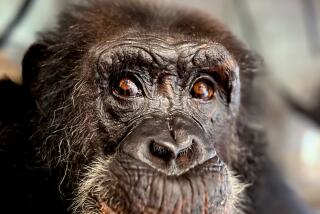The Chimpanzees of Gombe: PATTERNS OF BEHAVIOR by Jane Goodall (Harvard University: $30; 673 pp.)
- Share via
In March of 1739, an anonymous pamphlet lamented the death of the “late incomparable Chimpanzee.” One of the first apes to reach Europe alive, this chimp had spent five months in London eating at popular coffee houses and being addressed as “Madame.” She was no mere animal to her contemporaries but rather an exotic human being who could not speak.
By the mid-20th Century, the world was familiar with all three of the great apes. Scientists and lay-people alike had come to consider them dangerous animals who were quite different from ourselves and certainly not deserving of obituary notices.
Then in 1961, the paleontologist Louis S. B. Leakey arranged for Jane Goodall, then a young animal lover without university education, to observe a group of wild chimpanzees on the shores of Lake Tanganyika in Tanzania. He hoped that a description of chimpanzee social behavior would provide an understanding of the life of early man.
What happened is legend. Goodall habituated the chimpanzees to her presence and after several years had delineated the ranks, personalities and family relationships of one large chimpanzee group. She had also discovered that chimpanzees use reeds as tools to fish termites out of mounds. Her memoir of these early years, combined with frequent lecture appearances and especially the National Geographic television specials, have made Goodall and her chimpanzees household words throughout the world.
What many people did not know until publication of “The Chimpanzees of Gombe: Patterns of Behavior” is that the Gombe Stream Reserve has undergone many changes over the years, as has Goodall herself. The park has become an island of wilderness surrounded by land that has been cultivated right to its borders. This has crowded the chimpanzees and may account for the radical changes in their behavior. Goodall, in the meantime, has gone to Cambridge and gotten a Ph.D. For a period that ended in 1975, she supervised students from Cambridge and Stanford universities who established at Gombe a new computerized data collection system. This phase of research ended after terrorists kidnaped several students and held them for ransom, an episode that Goodall scarcely explains in her haste to credit the Tanzanian trackers who have helped her since then to maintain an unbroken record of observations.
In spite of the uncomfortable political situation, Goodall has managed to continue. In so doing, she has validated her commitment to the chimpanzees. She presents life portraits of individual animals for whom we know both lineage and descendants. This unique account of a quarter-century of research is contained in a single, beautifully produced volume. Illustrated with photographs, maps, graphs and charts, it also features “word pictures,” brief narratives of chimpanzee-watching from her field notes that lend an air of immediacy to the story.
The benign chimpanzees she describes in her early work behave with apparent malice with the change of conditions and the passage of time. Had she not stayed so long, she would not have observed the fission of the major group at Gombe, nor the deliberate obliteration of one group by the other through murder and infanticide. The long duration of the project enabled her to observe generational patterns of behavior, differential sexual characteristics and instances of apparent altruism as well as cannibalism and destruction. Goodall believes that the behaviors she has documented in animals which are among the species most closely related to Homo sapiens foreshadow the appearance of cruelty and warfare as well as some aspects of love in human beings.
Unlike those scientists who guard their objectivity by refusing to give names to the animals they observe, Goodall writes of each one intimately. She has been accused of “anthropomorphism,” the scientific sin of projecting human thoughts and emotions onto animals. But these animals she is documenting are extremely intelligent, and she argues that her affinity with each chimpanzee is what makes her research valuable.
She has also been accused of interfering with the natural behavior of the chimps by provisioning them with bananas and giving them medication when they were ill. She responds that the banana provisioning has long since been enormously reduced but that, in its heyday, it brought animals to her camp that might not have come by for weeks or months. And indeed, she defends her treatment and feeding of sick and dying animals on grounds that humans have habitually interfered with animal life in negative ways--destroying their habitats and introducing diseases. She is balancing the scales by interfering in a positive way. Above all, she suspects that without a high level of emotional involvement, her research would have ended years earlier.
Goodall’s chimps, Old Flo and Flint, have been accepted as quasi-human today, much as Madame Chimpanzee was in the 18th Century. (Flo’s obituary was in the Sunday Times of Britain.) But Goodall has done more than bring us full circle. The Londoners of the Enlightenment admired a rare creature for her obvious intelligence. They did not know anything about her. Thanks to the painstaking efforts of Goodall and her colleagues, we admire the chimpanzees of Gombe because we understand the complexity of their lives.
More to Read
Sign up for Essential California
The most important California stories and recommendations in your inbox every morning.
You may occasionally receive promotional content from the Los Angeles Times.













